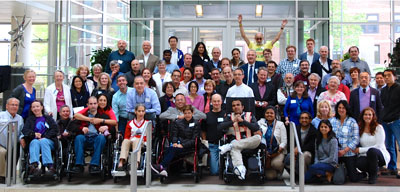
The first ever meeting of Neuroacanthocytosis patients, families and carers was held at the University of Michigan in Ann Arbor, Michigan in the US in May was a tremendous success. It was sponsored by The Allergan Foundation, Neurocrine Biosciences and the Advocacy.
The group photo above includes both patients/families and researchers/clinicians.
Thirteen patients and nineteen family members/carers attended in conjunction with the science meeting, with researchers and consultants sharing new work and outcomes with an international audience. The patients' meeting was streamed to offer understanding of the participants' experiences and questions.
A joint session was the first agenda item with introductions by Roger Albin, Bill Dauer and Chad Weinbaum with presentations by Adrian Danek, Ruth Walker and Ginger and Alex Irvine.
The family meeting continued with participants sharing histories and questions and learning about the history of the Advocacy.
After lunch there were presentations about Physical Therapy, Speech and Swallowing and Raiki by locale experts. The day ended with a poster session and reception/dinner with the scientific meeting participants.
Sunday brought together Adrian Danek and Ruth Walker for a medical Q&A, which was most useful for all participants. It was followed by a discussion of the future of the Advocacy; many ideas and offers of volunteer help were offered. After lunch the participants took more photos (our immense thanks to Jerry Paro whose photos feature here) and promised to keep in touch with ideas and support before the next meeting in Dresden in spring of 2018.
We were delighted the event had such a positive impact on patients and their families. Here are just some of the comments they made about the Ann Arbor meeting:
"Mark and I both thought the symposium went very well, and we deeply, deeply appreciate your making it happen. We came away inspired by the other patients and their families, and feeling not quite so alone".
"I found it to be very informative and the friends Ed and I made will last a lifetime."
"I found a huge experience sharing this time with Doctors as Danek and Ruth, patients and family, from whom I have also learned."
"Great to share, lovely inclusive, friendly sessions; thanks for all that was accomplished!'”
"I have learned a lot of things about ChAc, especially I know I am not alone; loved meeting all the others."
"We learned so much! We don't get a lot of info from the doctor - or ways to figure out where to get info. Tthe registry, blood tests, DNA and mutations were all subjects we learned more about."
For photos and streaming information about the Ann Arbor event, see this link.
SaveSaveSaveSaveSave